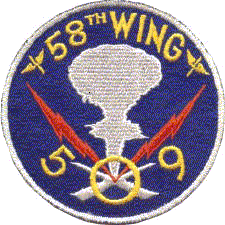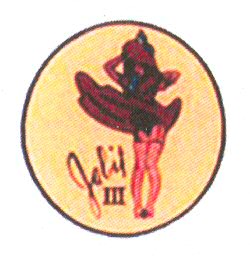
Straight Flush was the name of a B-29 Superfortress that participated in the atomic bomb attack on Hiroshima on August 6, 1945.

Wendover Air Force Base is a former United States Air Force base in Utah now known as Wendover Airport. During World War II, it was a training base for B-17 and B-24 bomber crews. It was the training site of the 509th Composite Group, the B-29 unit that carried out the atomic bombings of Hiroshima and Nagasaki.

The 509th Composite Group was a unit of the United States Army Air Forces created during World War II and tasked with the operational deployment of nuclear weapons. It conducted the atomic bombings of Hiroshima and Nagasaki, Japan, in August 1945.

The 509th Operations Group is the flying component of the United States Air Force 509th Bomb Wing, assigned to Whiteman Air Force Base, Missouri. It is equipped with all 20 of the USAF's B-2 Spirit stealth bombers, flown by its 393rd Bomb Squadron. Its 13th Bomb Squadron, the training unit for the 509th, provides training in T-38 Talon trainers as well as in the 393rd's B-2 Spirits.

Jabit III was the name of a B-29 Superfortress participating in the atomic bomb attack on Hiroshima on August 6, 1945. Assigned to the 393d Bomb Squadron, 509th Composite Group, Jabit III was used as a weather reconnaissance aircraft and flew to the city of Kokura, designated as the secondary target, before the final bombing to determine if conditions were favorable for an attack.

Necessary Evil, also referred to as Plane #91, was the name of Boeing B-29-45-MO Superfortress 44-86291, participating in the atomic bomb attack on Hiroshima on August 6, 1945.
Up An' Atom was the name of a B-29 Superfortress configured during World War II in the Silverplate project to carry an atomic bomb.
Laggin' Dragon was the name of a Boeing B-29 Superfortress configured to carry the atomic bomb in World War II.

Silverplate was the code reference for the United States Army Air Forces' participation in the Manhattan Project during World War II. Originally the name for the aircraft modification project which enabled a B-29 Superfortress bomber to drop an atomic weapon, "Silverplate" eventually came to identify the training and operational aspects of the program as well. The original directive for the project had as its subject line "Silver Plated Project" but continued usage of the term shortened it to "Silverplate".
Some Punkins was the name of a B-29 Superfortress modified to carry an atomic bomb during World War II.
Next Objective was the name of a Boeing B-29-36-MO Superfortress, 44-27299, Victor 86, modified to carry the atomic bomb in World War II.

Top Secret was the name of a Boeing B-29 Superfortress modified to carry the atomic bomb in World War II. It served with the Army Air Forces and United States Air Force from 1945 until 1954.
Strange Cargo was the name of a B-29 Superfortress modified to carry the atomic bomb in World War II.
Luke the Spook was the name of a Boeing B-29-50-MO Superfortress configured to carry the atomic bomb in World War II.

The 393rd Bomb Squadron is part of the 509th Bomb Wing at Whiteman Air Force Base, Missouri. It operates Northrop Grumman B-2 Spirit nuclear-capable strategic bomber aircraft.

The 313th Air Division is an inactive United States Air Force unit. It was initially organized in 1944 during World War II for use in the Pacific Theater of Operations. Its last assignment was with Pacific Air Forces at Kadena Air Base, Okinawa. It was inactivated on 1 October 1991.

The 302d Tactical Electronic Warfare Training Squadron was formed in September 1985 by the consolidation of three units which had served in the Army Air Forces or United States Air Force during World War II and the Cold War.

The 516th Aeronautical Systems Group is an inactive group of the United States Air Force (USAF). It was last assigned to the 516th Aeronautical Systems Wing of Air Force Materiel Command at Wright-Patterson Air Force Base, Ohio.

The 216th Army Air Forces Base Unit (Special) provided base services at Wendover Army Airfield, where the 509th Composite Group was stationed during World War II. As such, it became involved in the Manhattan Project's program of testing bombs and aircraft under the codename Project W-47.

The 971st Airborne Warning and Control Squadron is an inactive United States Air Force unit designation. It was designated on 15 January 1985 by the consolidation of the World War II 1st Troop Carrier Squadron, which was inactivated on 18 December 1945 at Fort Lawton, Washington; the 1st Strategic Support Squadron, which was inactivated on 15 January 1959 at Biggs Air Force Base, Texas, and the 1st Air Transport Squadron, which was inactivated on 20 June 1971 at Andrews Air Force Base, Maryland.
















